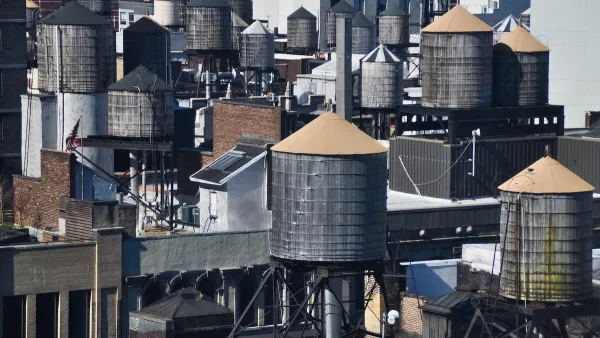Regulation and incentivization helped cities in the Western United States keep water usage and population growth on opposite trend lines.

Despite increasing populations, numerous western U.S. cities have reduced water use in the past 20 years, according to a new study. Melissa Sevigny interviewed the study's lead author Brian Richter to learn more about "how simple water conservation measures could be a cost-effective way to combat shortages in the Colorado River Basin."
Richter explains that of the 20 western cities, two-thirds saw water usage drop. "What we found across the board in the western Cities that we surveyed—we looked at 20 different cities—we found their average rate of growth from 2000 to 2015 was about 21 percent, yet their average rate of reduction in their water use was 19 percent," describes Richter in the interview.
Financial disincentives for landscaping irrigation has contributed significantly to the decline in water use, according to the article. "The other big part of the story was indoors, on toilets," says Richter. Richter points to the Federal Energy Policy Act of 1992, which reduced water use by mandating that new toilets sold in the United States would be highly energy efficient. "Overnight, the new toilets being sold were using half of the water that they did previously," Richter notes.
According to Richter, the precedent that has been set for water conservation so far still leaves a lot of room for improvement.
FULL STORY: Study: Water Use Dropping In Western Cities Even While Population Grows

Analysis: Cybertruck Fatality Rate Far Exceeds That of Ford Pinto
The Tesla Cybertruck was recalled seven times last year.

National Parks Layoffs Will Cause Communities to Lose Billions
Thousands of essential park workers were laid off this week, just before the busy spring break season.

Retro-silient?: America’s First “Eco-burb,” The Woodlands Turns 50
A master-planned community north of Houston offers lessons on green infrastructure and resilient design, but falls short of its founder’s lofty affordability and walkability goals.

Test News Post 1
This is a summary

Analysis: Cybertruck Fatality Rate Far Exceeds That of Ford Pinto
The Tesla Cybertruck was recalled seven times last year.

Test News Headline 46
Test for the image on the front page.
Urban Design for Planners 1: Software Tools
This six-course series explores essential urban design concepts using open source software and equips planners with the tools they need to participate fully in the urban design process.
Planning for Universal Design
Learn the tools for implementing Universal Design in planning regulations.
EMC Planning Group, Inc.
Planetizen
Planetizen
Mpact (formerly Rail~Volution)
Great Falls Development Authority, Inc.
HUDs Office of Policy Development and Research
NYU Wagner Graduate School of Public Service




























